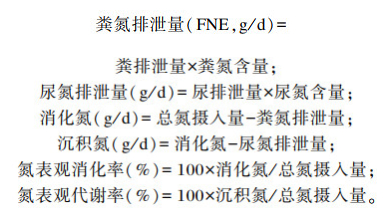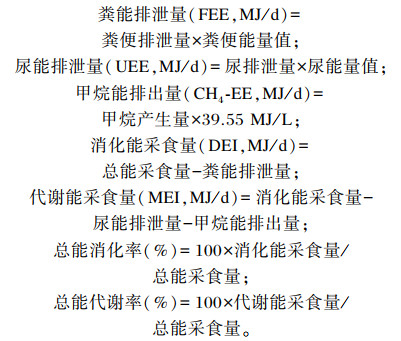2. 吉林省农业科学院畜牧所, 公主岭 136100;
3. 湖南农业大学动物科学技术学院, 长沙 410128
2. Institute of Animal Husbandry, Jilin Academy of Agricultural Sciences, Gongzhuling 136100, China;
3. College of Animal Science and Technology, Hunan Agricultural University, Changsha 410128, China
草原红牛是我国自主培育的乳肉兼用型优良地方品种,具有适应性强、耐粗饲、抗逆性强以及肉质鲜嫩等优良特性,广泛分布于吉林、河北和内蒙古等地[1]。为促进草原红牛品种的开发利用,部分学者从遗传育种角度,围绕草原红牛的种质资源特性、功能基因挖掘和遗传性状改良等方面开展研究,取得了系列成果[2-3]。而从动物营养角度开展的草原红牛营养需要及养分代谢规律方面的研究还不足,这导致草原红牛的饲养缺乏参考标准,严重制约了品种的推广应用,亟需开展相关研究。蛋白质是动物机体的重要组成成分,饲粮粗蛋白质是动物生长所需蛋白质的主要来源,与动物生产性能、屠宰性能和畜产品品质等密切相关[4]。赵洋洋等[5]研究表明,提高饲粮粗蛋白质水平可以提高奶公牛饲料转化率,增加眼肌面积,改善生产和屠宰性能。Hristov等[6]研究报道,给泌乳奶牛供给过高的饲粮粗蛋白质会显著降低氮利用率,且过多的氮会转变成尿氮排出。Li等[7]研究发现,饲粮粗蛋白质水平对安格斯和湘西黄牛杂交牛的生产性能和养分利用率无显著影响,但可提高其屠宰率。可见,适宜的饲粮粗蛋白质水平对于发挥动物最佳生产性能、提高饲料利用效率以及改善胴体品质等具有重要作用。本课题组前期已完成饲粮能量水平对草原红牛消化代谢的影响研究,得出适宜饲粮能量水平[8],但关于饲粮粗蛋白质水平对草原红牛的影响研究尚未见报道,需开展系统研究。基于此,为进一步提高草原红牛科学饲养水平,深入挖掘品种生长特性,本研究以体重为450 kg左右的草原红牛为研究对象,继续开展饲粮粗蛋白质水平对草原红牛呼吸代谢、养分表观消化率和血清生化指标等方面的研究,以明确饲粮粗蛋白质的适宜水平,为草原红牛饲养标准的制订提供基础数据。
1 材料与方法 1.1 试验设计试验采用单因素试验设计,选用12头体重相近[(473.08±14.20) kg]、健康的草原红牛公牛,随机分为3组,每组4头。各组分别饲喂不同粗蛋白质水平的饲粮,饲粮参考NRC(2016)[9]并结合生产实际进行配制,低蛋白质组、中蛋白质组和高蛋白质组饲粮粗蛋白质水平理论值分别为8.00%、10.00%和12.00%,实测值分别为8.15%、10.67%和12.60%,饲粮组成及营养水平见表 1。试验期20 d,包括预试期18 d和正试期2 d。试验在吉林省农业科学院畜牧分院试验牛场进行,于2020年11月开展。
|
|
表 1 饲粮组成及营养水平(风干基础) Table 1 Composition and nutrient levels of diets (air-dry basis) |
预试期,试验牛单栏栓系饲养,每天07:00和17:00分别饲喂1次,先精后粗,自由饮水。预试期监测各组采食量,调节各组采食量基本一致。正试期将所有试验牛转入呼吸测热室内栓系饲养,饲养程序与预试期完全相同。正试期利用吉林省农业科学院自主研制的“大型动物开放回流式呼吸测热装置”进行呼吸代谢试验[10],检测并记录呼吸代谢室气体及气体变化,连续记录2 d。同时,采用全收粪尿法收集每头牛每天的粪便和尿液,连续收集2 d,开仓收集粪尿的时间为每日气体数据采集完成之后。每天采集的粪便全部称重并作好记录,充分混合均匀后分成2份,1份制备风干样本待测,1份固氮后用于氮含量检测。每天的尿液全部收集后,用量筒准确记录,用6层纱布过滤后,量取每头牛每天尿样的10%置于干净塑料瓶中,固氮后密封于-20 ℃待测。试验结束时,每头牛颈静脉采集血样10 mL,4 ℃条件下3 000 r/min离心15 min,分离血清后于-20 ℃保存待测。
1.3 测定指标及方法 1.3.1 气体代谢及产热量利用呼吸代谢室检测试验牛的氧气消耗量、二氧化碳产生量和甲烷产生量等,并计算呼吸熵和产热量[11]。

|
利用凯氏定氮仪(Kjeltec 8400,FOSS)测定样本氮含量,计算氮代谢相关参数。

|
利用氧弹式测热仪(C2000,IKA)测定样本能量值,根据甲烷产生量计算甲烷能量值,并计算能量代谢参数。

|
按照《饲料分析及饲料质量检测技术》[12]测定饲粮、粪便样本的干物质(DM)、有机物(OM)、粗脂肪(EE)、中性洗涤纤维(NDF)和酸性洗涤纤维(ADF)含量,计算养分表观利用率。

|
利用试剂盒(南京建成生物工程研究所)检测血清葡萄糖(GLU)、甘油三酯(TG)、总胆固醇(TC)、总蛋白(TP)和尿素氮(UN)含量。
1.4 数据统计分析数据经Excel 2010整理后,采用SPSS 20.0软件中的单因素方差分析(one-way ANOVA)进行统计分析,多重比较采用Tukey法进行,采用多项式比较分析一次线性效应,结果以平均值和均值标准误(SEM)表示,P < 0.05为差异显著,0.05≤P < 0.10表示有变化趋势。
2 结果 2.1 饲粮粗蛋白质水平对草原红牛呼吸代谢的影响由表 2可知,低蛋白质组草原红牛甲烷产生量、氧气消耗量、二氧化碳产生量和产热量均显著高于其他2组(P < 0.05),且上述指标均随饲粮粗蛋白质水平的升高而线性降低(P < 0.05);低蛋白质组呼吸熵显著低于其他2组(P < 0.05),且呼吸熵随饲粮粗蛋白质水平的升高而线性升高(P < 0.05)。
|
|
表 2 饲粮粗蛋白质水平对草原红牛呼吸代谢的影响 Table 2 Effects of dietary crude protein levels on respiration metabolism of Steppe Red cattle |
由表 3可知,各组草原红牛粪氮排泄量无显著差异(P>0.05);高蛋白质组尿氮排泄量显著高于其他2组(P < 0.05),低蛋白质组消化氮和沉积氮显著低于其他2组(P < 0.05),且上述指标随饲粮粗蛋白质水平的升高而线性升高(P < 0.05);饲粮粗蛋白质水平对草原红牛氮表观消化率和氮表观代谢率均无显著影响(P>0.05)。
|
|
表 3 饲粮粗蛋白质水平对草原红牛氮代谢的影响 Table 3 Effects of dietary crude protein levels on nitrogen metabolism of Steppe Red cattle |
由表 4可知,饲粮粗蛋白质水平对草原红牛粪能排泄量、尿能排泄量、消化能采食量、代谢能采食量、总能消化率和总能代谢率等均无显著影响(P>0.05),尿能排泄量有随饲粮粗蛋白质水平的升高而升高的趋势(P=0.056);低蛋白质组甲烷能排出量和甲烷能排出量/总能值均显著高于其他2组(P < 0.05),且两者随饲粮粗蛋白质水平的升高而线性降低(P < 0.05)。
|
|
表 4 饲粮粗蛋白质水平对草原红牛能量代谢的影响 Table 4 Effects of dietary crude protein levels on energy metabolism of Steppe Red cattle |
由表 5可知,饲粮粗蛋白质水平对各组草原红牛的干物质、有机物、粗脂肪、中性洗涤纤维和酸性洗涤纤维的表观消化率均无显著影响(P>0.05)。
|
|
表 5 饲粮粗蛋白质水平对草原红牛养分表观消化率的影响 Table 5 Effects of dietary crude protein levels on nutrient apparent digestibility of Steppe Red cattle |
由表 6可知,各组草原红牛血清葡萄糖、甘油三酯、总胆固醇和总蛋白含量均无显著差异(P> 0.05)。高蛋白质组血清尿素氮含量显著高于其他2组(P < 0.05),且血清尿素氮含量随饲粮粗蛋白质水平的升高而线性升高(P < 0.05)。
|
|
表 6 饲粮粗蛋白质水平对草原红牛血清生化指标的影响 Table 6 Effects of dietary crude protein levels on serum biochemical indices of Steppe Red cattle |
反刍动物瘤胃发酵产生甲烷,据报道,饲粮中的总能有2%~15%以甲烷形式损失;氧气消耗量和二氧化碳产生量通常与机体代谢强度有关,从营养学角度降低动物碳排放一直是研究的热点问题[13-14]。蛋白质是动物饲粮营养成分的重要指标,已有报道发现饲粮蛋白质水平与反刍动物气体代谢存在相关性,但研究结论存在差异。Moss等[15]在饲喂牧草青贮的杂交羊饲粮中添加豆粕,发现当饲粮粗蛋白质水平提高时(13.9%~22.5%),杂交羊的甲烷产生量降低。Kidane等[16]报道,饲粮粗蛋白质水平(13.0%~17.5%)对奶牛的甲烷产生量无显著影响,但高蛋白质水平组奶牛的每千克牛奶折合的甲烷产生量升高。陈跃凤[17]报道,饲粮粗蛋白质水平(13.93%~15.77%)对夏南牛甲烷产生量无显著影响,但提高粗蛋白质水平有降低甲烷产生量的趋势。本研究发现,低蛋白质组草原红牛甲烷产生量最高,提高饲粮粗蛋白质水平可降低甲烷产生量,这与Moss等[15]和陈跃凤[17]研究结果类似。反刍动物甲烷的产生与瘤胃产甲烷微生物活动有关,同时瘤胃挥发性脂肪酸的比例也影响甲烷产生[4]。已有报道表明,饲粮粗蛋白质水平对瘤胃挥发性脂肪酸含量无显著影响[18-19],因此推测甲烷产生量差异可能与不同蛋白质组草原红牛瘤胃产甲烷微生物活动不同有关,但具体机制尚需验证。此外,研究结果还发现,低蛋白质组草原红牛氧气消耗量、二氧化碳产生量和产热量显著高于其他2组,而本研究中各组草原红牛采食量基本一致,饲粮能量摄入量无显著区别,推测低蛋白质组草原红牛可能由于饲粮蛋白质供给量低、能蛋比不平衡造成机体代谢强度发生变化[20]。
3.2 饲料粗蛋白质水平对草原红牛氮和能量代谢的影响饲粮适宜粗蛋白质水平是提高动物氮和能量利用效率的重要因素,饲粮蛋白质供给不足时难以满足动物营养需要影响生产性能,而饲粮蛋白质供给过高时过多的氮会从粪尿中排出,会加重机体代谢负担,降低饲料利用率[4]。本研究结果表明,高蛋白质组草原红牛尿氮排泄量显著高于其他2组,是其他组近2倍,但高蛋白质组和中蛋白质组之间消化氮和沉积氮无显著差异,这说明给草原红牛饲粮中提供过量的蛋白质时,大量的氮会通过尿液排出体外,氮的利用率难以提高,这与已有报道结果[21-22]类似。此外,虽然低蛋白质组草原红牛粪氮和尿氮排泄量较中蛋白质组差异不显著,但其消化氮和沉积氮却显著降低,分析原因可能是饲粮蛋白质过低导致瘤胃微生物蛋白合成受阻,影响了饲粮中氮的利用效率[4, 23]。进一步分析草原红牛的能量代谢参数发现,尿能排泄量随饲粮粗蛋白质水平的升高而呈线性升高趋势,这可能与饲粮高蛋白质水平导致尿氮排泄量提高有关,其他能量代谢指标不受饲粮粗蛋白质水平的影响。此外,与气体代谢结果一致的是,草原红牛甲烷能排出量、甲烷能排出量/总能值均以低蛋白质组最高,说明饲粮粗蛋白质水平过低时,饲粮能量以甲烷形式损失的比例提高,这可能与饲粮蛋白质水平过低影响瘤胃产甲烷微生物活动有关,具体机理还需深入研究。
3.3 饲粮粗蛋白质水平对草原红牛养分表观消化率的影响养分表观消化率是反映饲粮配比是否合理、营养是否均衡的重要指标,饲粮粗蛋白质水平可影响养分表观消化率。Broderick[24]报道,初产荷斯坦奶牛的中性洗涤纤维和酸性洗涤纤维的表观消化率随饲粮粗蛋白质水平的升高(15.1%~18.4%)而线性升高,但干物质和有机物表观消化率不受影响。Aguerre等[25]研究发现,提高饲粮粗蛋白质水平(15.3%~16.6%)可提高荷斯坦奶牛的干物质和有机物的表观消化率,不影响中性洗涤纤维表观消化率。但Hristov等[6]、Corea等[26]的研究均表明饲粮粗蛋白质水平对养分表观消化率无显著影响。本课题组前期研究发现,草原红牛的养分表观消化率随饲粮能量水平的升高而升高[8],但本研究发现饲粮粗蛋白质水平对养分表观消化率无显著影响,说明草原红牛可能对饲粮粗蛋白质水平变化的敏感度较低。
3.4 饲粮粗蛋白质水平对草原红牛血清生化指标的影响血清生化指标的变化与动物机体对饲粮养分的吸收代谢过程密切相关。本研究结果表明,饲粮粗蛋白质水平对草原红牛血清葡萄糖、甘油三酯和总胆固醇含量等指标均无显著影响,说明饲粮粗蛋白质水平对草原红牛的碳水化合物和脂肪代谢过程未产生较大影响。但高蛋白质组血清尿素氮含量显著高于其他2组,这与Park等[27]、程光民等[28]的研究结果类似。血清尿素氮是反映机体氮代谢的重要指标,受进食氮和内源氮的影响,血清尿素氮与进食氮含量在一定范围内呈正相关[29]。本研究中,随着饲粮粗蛋白质水平的提高,草原红牛进食的蛋白质含量逐渐升高,因此血清尿素氮含量随之上升[30]。
4 结论本试验条件下,适宜提高饲粮粗蛋白质水平可降低草原红牛的甲烷产生量,降低氧气消耗量、二氧化碳产生量和产热量;适宜提高饲粮粗蛋白质水平可提高草原红牛消化氮和沉积氮的量,但不影响能量和各养分的表观消化率。综合各项指标以中蛋白质组效果最佳,推荐450 kg左右草原红牛饲粮粗蛋白质水平以10.00%为宜,消化氮和消化能日供给量分别为110.61 g/d和102.21 MJ/d,沉积氮和代谢能日供给量分别为98.17 g/d和92.67 MJ/d。
| [1] |
李向阳, 王学理, 霍晓伟, 等. 草原红牛及其杂种牛微卫星标记与生产性能?[J]. 吉林农业大学学报, 2015, 37(6): 715-718. LI X Y, WANG X L, HUO X W, et al. Study on microsatellite marker and production capacity of steppe red cattle and their cross-bred cattle[J]. Journal of Jilin Agricultural University, 2015, 37(6): 715-718 (in Chinese). |
| [2] |
吕阳, 曹阳, 高一, 等. 草原红牛ACSL3基因CDS区克隆、生物信息学分析及组织表达研究[J]. 中国畜牧兽医, 2019, 46(4): 957-966. LYU Y, CAO Y, GAO Y, et al. Cloning, bioinformatics and tissue expression analysis of ACSL3 gene CDS in red steppe cattle[J]. China Animal Husbandry & Veterinary Medicine, 2019, 46(4): 957-966 (in Chinese). |
| [3] |
LIU L X, WU J, GAO Y, et al. The effect of Acot2 overexpression or downregulation on the preadipocyte differentiation in Chinese Red Steppe cattle[J]. Adipocyte, 2020, 9(1): 279-289. DOI:10.1080/21623945.2020.1776553 |
| [4] |
王之盛, 李胜利. 反刍动物营养学[M]. 北京: 中国农业出版社, 2016. WANG Z S, LI S L. Ruminant nutrition[M]. Beijing: China Agriculture Press, 2016 (in Chinese). |
| [5] |
赵洋洋, 韩永胜, 李伟, 等. 不同蛋白质水平高精料饲粮对荷斯坦奶公牛育肥性能、养分表观消化率及血清生化指标的影响[J]. 动物营养学报, 2019, 31(7): 3123-3134. ZHAO Y Y, HAN Y S, LI W, et al. Effects of high concentrate diets with different protein levels on fattening performance, nutrient apparent digestibility and serum biochemical indices of Holstein bulls[J]. Chinese Journal of Animal Nutrition, 2019, 31(7): 3123-3134 (in Chinese). DOI:10.3969/j.issn.1006-267x.2019.07.023 |
| [6] |
HRISTOV A N, ETTER R P, ROPP J K, et al. Effect of dietary crude protein level and degradability on ruminal fermentation and nitrogen utilization in lactating dairy cows[J]. Journal of Animal Science, 2004, 82(11): 3219-3229. DOI:10.2527/2004.82113219x |
| [7] |
LI L Y, ZHU Y K, WANG X Y, et al. Effects of different dietary energy and protein levels and sex on growth performance, carcass characteristics and meat quality of F1 Angus×Chinese Xiangxi yellow cattle[J]. Journal of Animal Science and Biotechnology, 2014, 5(1): 21. DOI:10.1186/2049-1891-5-21 |
| [8] |
刘基伟, 张相伦, 李旭, 等. 饲粮能量水平对草原红牛代谢及血清指标的影响[J]. 中国农业科学, 2020, 53(12): 2502-2511. LIU J W, ZHANG X L, LI X, et al. Effects of dietary energy levels on metabolism and serum parameters of steppe red cattle[J]. Scientia Agricultura Sinica, 2020, 53(12): 2502-2511 (in Chinese). DOI:10.3864/j.issn.0578-1752.2020.12.016 |
| [9] |
National Academies of Sciences, Engineering, and Medicine. Nutrient requirements of beef cattle[M]. 8th ed. Washington, D.C.: The National Academies Press, 2016.
|
| [10] |
班志彬, 梁浩, 杨华明. 大型动物"开放回流式呼吸测热装置"的研制及应用试验[J]. 中国畜牧兽医文摘, 2014, 30(2): 185-187. BAN Z B, LIANG H, YANG H M. Development and application of "open return flow respiratory calorimeter equipment" for large animals[J]. Chinese Abstracts of Animal Husbandry and Veterinary Medicine, 2014, 30(2): 185-187 (in Chinese). |
| [11] |
周虹. 吐温80和人参皂甙对绵羊能量代谢和温室气体排放量的影响[D]. 硕士学位论文. 长春: 吉林农业大学, 2016. ZHOU H. Effect of Tween 80 and ginseng saponins on sheep energy metabolism and greenhouse gases production[D]. Master's Thesis. Changchun: Jilin Agricultural University, 2016. (in Chinese) |
| [12] |
张丽英. 饲料分析及饲料质量检测技术[M]. 3版. 北京: 中国农业大学出版社, 2007. ZHANG L Y. Feed analysis and feed quality testing technology[M]. 3rd ed. Beijing: China Agricultural University Press, 2007 (in Chinese). |
| [13] |
王晓霞, 王侃, 吴晨晖, 等. 无患子皂甙对瘤胃发酵及甲烷产量的影响[J]. 中国畜牧杂志, 2012, 48(17): 55-58. WANG X X, WANG K, WU C H, et al. The effects of sapindoside on rumen fermentation and methane production in vitro[J]. Chinese Journal of Animal Science, 2012, 48(17): 55-58 (in Chinese). DOI:10.3969/j.issn.0258-7033.2012.17.015 |
| [14] |
MADSEN J, BJERG B S, HVELPLUND T, et al. Methane and carbon dioxide ratio in excreted air for quantification of the methane production from ruminants[J]. Livestock Science, 2010, 129(1/3): 223-227. |
| [15] |
MOSS A R, GIVENS D I. The effect of supplementing grass silage with soya bean meal on digestibility, in sacco degradability, rumen fermentation and methane production in sheep[J]. Animal Feed Science and Technology, 2002, 97(3/4): 127-143. |
| [16] |
KIDANE A, ØVERLAND M, MYDLAND L T, et al. Interaction between feed use efficiency and level of dietary crude protein on enteric methane emission and apparent nitrogen use efficiency with Norwegian red dairy cows1[J]. Journal of Animal Science, 2018, 96(9): 3967-3982. DOI:10.1093/jas/sky256 |
| [17] |
陈跃凤. 精料中高蛋白和淀粉水平对肉牛肠道甲烷、氮磷排放和瘤胃菌群影响[D]. 硕士学位论文. 郑州: 河南农业大学, 2017. CHEN Y F. Effects of high protein and starch concentrate on methane emission, nitrogen and phosphorus emission and rumen microflora in beef cattle[D]. Master's Thesis. Zhengzhou: Henan Agricultural University, 2017. (in Chinese) |
| [18] |
ZHANG B, WANG C, LIU H, et al. Effects of dietary protein level on growth performance and nitrogen excretion of dairy heifers[J]. Asian-Australasian Journal of Animal Sciences, 2017, 30(3): 386-391. |
| [19] |
RAFIEE-YARANDI H, ALIKHANI M, GHORBANI G R, et al. Dietary protein level and corn processing method: lactation performance, milk fatty acid composition, rumen and blood parameters of lactation dairy cows[J]. Livestock Science, 2019, 221: 95-104. DOI:10.1016/j.livsci.2019.01.019 |
| [20] |
马媚. 不同能量蛋白水平日粮对奶牛能量代谢及生产性能的影响[D]. 硕士学位论文. 北京: 中国农业大学, 2005. MA M. Effect of energy and protein level on energy metabolism and productivity of dairy cows[D]. Master's Thesis. Beijing: China Agricultural University, 2005. (in Chinese) |
| [21] |
LEE C, GIALLONGO F, HRISTOV A N, et al. Effect of dietary protein level and rumen-protected amino acid supplementation on amino acid utilization for milk protein in lactating dairy cows[J]. Journal of Dairy Science, 2015, 98(3): 1885-1902. DOI:10.3168/jds.2014-8496 |
| [22] |
MENEZES A C B, VALADARES FILHO S C, COSTA E SILVA L F, et al. Does a reduction in dietary crude protein content affect performance, nutrient requirements, nitrogen losses, and methane emissions in finishing Nellore bulls?[J]. Agriculture, Ecosystems & Environment, 2016, 223: 239-249. |
| [23] |
徐俊, 侯玉洁, 赵国琦, 等. 不同蛋白和中性洗涤纤维水平对瘤胃发酵、消化和微生物蛋白合成的影响[J]. 中国畜牧杂志, 2013, 49(7): 43-48. XU J, HOU Y J, ZHAO G Q, et al. Effect of different dietary levels of protein and NDF on the ruminal fermentation, digestibility and microbial protein synthesis in vitro[J]. Chinese Journal of Animal Science, 2013, 49(7): 43-48 (in Chinese). DOI:10.3969/j.issn.0258-7033.2013.07.012 |
| [24] |
BRODERICK G A. Effects of varying dietary protein and energy levels on the production of lactating dairy cows[J]. Journal of Dairy Science, 2003, 86(4): 1370-1381. DOI:10.3168/jds.S0022-0302(03)73721-7 |
| [25] |
AGUERRE M J, CAPOZZOLO M C, LENCIONI P, et al. Effect of quebracho-chestnut tannin extracts at 2 dietary crude protein levels on performance, rumen fermentation, and nitrogen partitioning in dairy cows[J]. Journal of Dairy Science, 2016, 99(6): 4476-4486. DOI:10.3168/jds.2015-10745 |
| [26] |
COREA E E, AGUILAR J M, ALAS N P, et al. Effects of dietary cowpea (Vigna sinensis) hay and protein level on milk yield, milk composition, N efficiency and profitability of dairy cows[J]. Animal Feed Science and Technology, 2017, 226: 48-55. DOI:10.1016/j.anifeedsci.2017.02.002 |
| [27] |
PARK A F, SHIRLEY J E, TITGEMEYER E C, et al. Effect of protein level in prepartum diets on metabolism and performance of dairy cows[J]. Journal of Dairy Science, 2002, 85(7): 1815-1828. DOI:10.3168/jds.S0022-0302(02)74256-2 |
| [28] |
程光民, 陈凤梅, 伏桂华, 等. 不同蛋白质水平日粮对中国荷斯坦奶牛生产性能、氮消化和血液生化指标的影响[J]. 畜牧与兽医, 2019, 51(1): 35-39. CHENG G M, CHEN F M, FU G H, et al. Effects of different crude protein levels in diet on milk production performance, nitrogen digestion and biochemical indexes of blood in Holstein cows[J]. Animal Husbandry & Veterinary Medicine, 2019, 51(1): 35-39 (in Chinese). |
| [29] |
刘清锋, 郑开之, 姜俊芳, 等. 不同蛋白质水平饲粮对3~4月龄中国荷斯坦犊牛生长性能及消化率的影响[J]. 畜牧与兽医, 2021, 53(4): 32-37. LIU Q F, ZHENG K Z, JIANG J F, et al. Effect of dietary protein levels on the growth performance, nutrient digestibility and serum biochemical indices of 3 to 4 month old Chinese Holstein calves[J]. Animal Husbandry & Veterinary Medicine, 2021, 53(4): 32-37 (in Chinese). |
| [30] |
黄杰. 不同蛋白水平全价颗粒料对公犊牛生长性能、血清生化指标及瘤胃发酵的影响[D]. 硕士学位论文. 扬州: 扬州大学, 2020. HUANG J. Effects of full-price granule with different protein levels on growth performance, serum biochemical indexes and rumen fermentation of male calves[D]. Master's Thesis. Yangzhou: Yangzhou University, 2020. (in Chinese) |




